





Kidneys
Kidneys – the pair parenchymatous bodies forming urine.
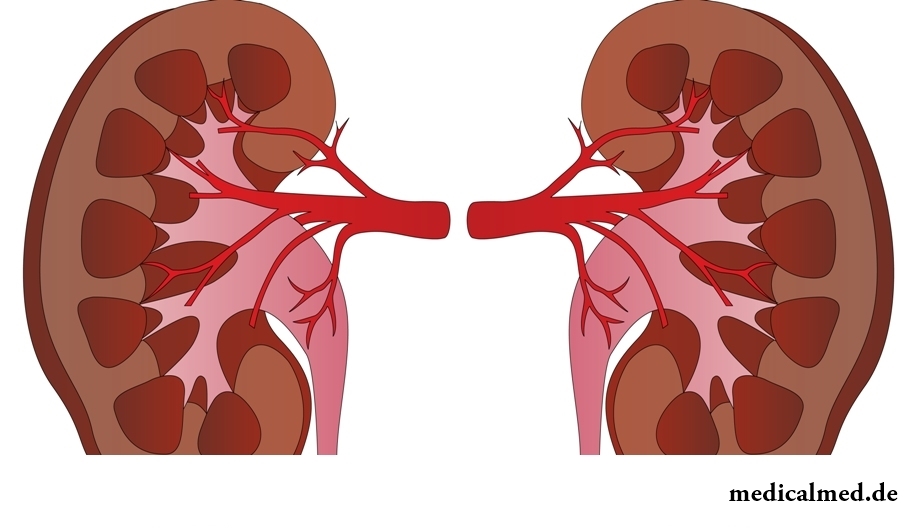
Kidney structure
Kidneys are located on both sides of a backbone in retroperitoneal space, that is the leaf of a peritoneum covers only their front party. Borders of an arrangement of these bodies widely vary even within norm. Usually left kidney is located a little above right.
The periblast of body is formed by the fibrous capsule. The fibrous capsule is covered by fatty. Renal covers together with a renal bed and the renal leg consisting of blood vessels, nerves, an ureter and a pelvis belong to the fixing kidney device.
Anatomically the structure of a kidney reminds a type of a bean. In it allocate an upper and lower pole. The concave inner edge which deepening the renal leg enters is called gate.
On a section the structure of a kidney is heterogeneous – the blanket of dark red color is called cortical substance which is formed by renal little bodies, distal and proximal tubules of nephron. Thickness of a bast layer varies from 4 to 7 mm. The deep layer of light gray color is called a medulla, it not continuous, is formed by the triangular pyramids consisting of collective tubules, papillary channels. Papillary channels come to an end on a top of a renal pyramid with papillary openings which open in renal cups. Cups merge and form a uniform cavity – a renal pelvis which in hiluses renalis proceeds in an ureter.
At the microlevel of a structure of a kidney allocate its main structural unit – nephron. Total quantity of nephrons reaches 2 million. Are a part of nephron:
- Vascular ball;
- Ball capsule;
- Proximal tubule;
- Henle's loop;
- Distal tubule;
- Collective tubule.
The vascular ball is formed by network of capillaries in which filtering from plasma of primary urine begins. Membranes through which filtering is carried out have so narrow time that do not pass through them normal proteinaceous molecules. At advance of primary urine on system of tubules and tubules from it ions, glucose and amino acids, important for an organism, are actively soaked up, and the fulfilled products of exchange remain and concentrate. Already secondary urine comes to renal cups.
Functions of kidneys
The main function of kidneys – secretory. They form urine with which of an organism toxic decomposition products of proteins, fats, carbohydrates are removed. Thus in an organism the homeostasis and acid-base equilibrium, including the maintenance of the vital potassium ions, sodium is supported.
Where the distal tubule adjoins to a ball pole, the so-called "dense spot" where special juxtaglomerular cells synthesize substances a renin and erythropoetin is located.
Formation of a renin is stimulated with lowering of blood pressure and sodium ions in urine. The renin promotes transformation of angiotensinogen into the angiotensin capable to increase pressure due to narrowing of blood vessels and strengthening of sokratitelny ability of a myocardium.
Erythropoetin stimulates formation of cells of red blood – erythrocytes. Formation of this substance is stimulated by a hypoxia – decrease in content of oxygen in blood.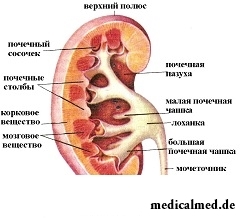
Diseases of kidneys
The group of diseases which break secretory function of kidneys is quite extensive. An infection in different departments of kidneys, an autoimmune inflammation, disbolism can be etiologies. Often pathological process in kidneys is a consequence of other diseases.
Glomerulonephritis – an inflammation of renal balls in which urine filtering is carried out. Infectious and autoimmune processes in kidneys can be the cause. At this disease of kidneys integrity of the filtering membrane of balls is broken, and proteins and blood cells begin to get into urine.
The main symptoms of a glomerulonephritis are hypostases, increase in arterial pressure and detection of a large number of erythrocytes, cylinders and protein in urine. Treatment of kidneys at a glomerulonephritis surely includes anti-inflammatory, antibacterial, antiagregantny and corticosteroid drugs.
Pyelonephritis – an inflammatory disease of kidneys. The pyelocaliceal device and intersticial (intermediate) fabric is involved in process of an inflammation. Most often the pyelonephritis reason – microbic infection.
The general reaction of an organism to an inflammation in the form of fever, feeling sick, headaches, nausea will be symptoms of pyelonephritis. Such patients complain of back pains which amplify at percussion in kidneys, release of urine can decrease. In analyses of urine there are inflammation signs – leukocytes, bacteria, slime. If the disease repeats often, that is risk of its transition to a chronic form.
Treatment of kidneys at pyelonephritis without fail includes antibiotics and uroseptik, sometimes several courses in a row, diuretic, disintoxication and symptomatic means.
The urolithiasis is characterized by formation of stones in kidneys. The main reason for it is disbolism and change of acid-base properties of urine. Danger of finding of stones in kidneys is that they can block urinary tract and break urine outflow. At stagnation of urine renal fabric can easily be infected.
The back pains (can be only on the one hand) amplifying after an exercise stress will be symptoms of an urolithiasis. The urination is speeded up and causes pain. At hit of a stone from a kidney in an ureter pain extends down, to the inguinal area and generative organs. Such attacks of pain are called renal colic. Sometimes after its attack in urine small stones and blood are found.
Finally to get rid of stones in kidneys, it is necessary to adhere to the special diet reducing a lithogenesis. At the small sizes of stones in treatment of kidneys use special drugs for their dissolution on the basis of urodezoksikholevy acid. Some collecting herbs (an immortelle, cowberry, a ptarmigan-berry, fennel, a horsetail) possess medical action at an urolithiasis.
When stones rather large or do not give in to dissolution, for their crushing use ultrasound. In case of emergency surgical removal them from kidneys can be necessary.
Stomatologists appeared relatively recently. In the 19th century to pull out painful teeth belonged to duties of the ordinary hairdresser.

Run - one of the most available and effective ways to revitalize the organism. Knowing about its extraordinary advantage, each of us though...
Section: Articles about health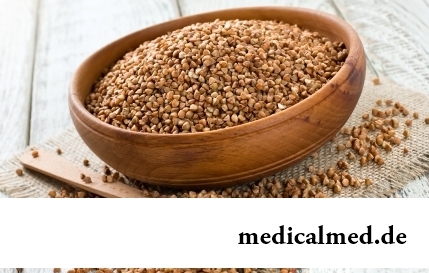
History of cultivation of a buckwheat contains more than five thousand years. Grain which is received from this plant is used for preparation of porridges, soups, baked puddings and puddings, do flour which is one of the main ingredients of the noodles popular in of it...
Section: Articles about health
Aspirin (acetylsalicylic acid) – one of those drugs which are known literally to all. It is available in each home first-aid kit, and many accept it at the first signs of an indisposition, often without having a fair idea of properties and therapeutic effect of drug. Meanwhile, impact of aspirin on a human body is very various, and is not always favorable. About it it is important to foreknow, in order to avoid emergence of problems with health....
Section: Articles about health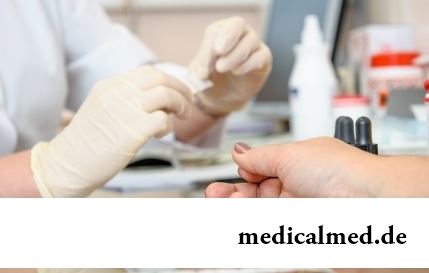
Each person knows that fervescence is an illness sign. However about existence of diseases can to suite...
Section: Articles about health
All diseases from nerves – in this joke a big element of truth, are said by doctors. Constant stresses lead to decrease in protective forces of an organism, and it becomes vulnerable for a set of diseases. It is wrong to think that the stress is a problem of the present. Life of people and hundred...
Section: Articles about health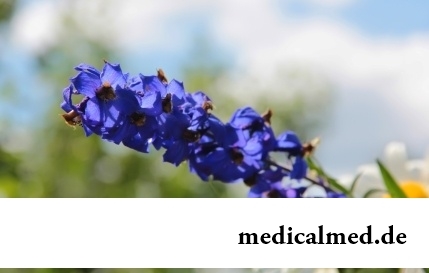
It is impossible to imagine human life in which there would be no plants. Practically in each apartment and any production room there are window plants, millions of people with pleasure are engaged in gardening and truck farming, many citizens spend free time on seasonal dachas. However we very seldom pay attention to those properties of our green pets who can make the neighbourhood with them unpleasant and even unsafe....
Section: Articles about health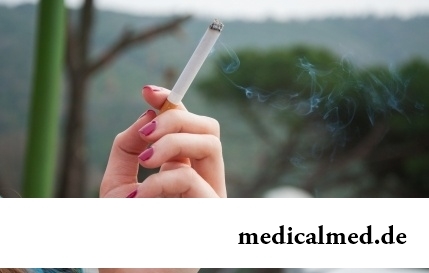
Statistically, in Russia about 34% of citizens smoke. Most of consumers of tobacco has problems about health sooner or later...
Section: Articles about health
Season of activity of viral infections in the heat. Everyone can get sick, but probability of this unpleasant event it is possible and it is necessary to minimize. There is a number of rules, following to which will help or to avoid absolutely infection with flu or a SARS, or to have an illness...
Section: Articles about health
It would seem, to buy drugs in Moscow does not make a problem – a drugstore, and not one, is available for each resident of the capital within walking distance. And, nevertheless, Internet drugstores become more popular – what it is possible to explain such phenomenon with? Actually there is a lot of reasons and if to formulate them it is short, then the most suitable word will be - "conveniently". We suggest to get acquainted in more detail with pluses and minuses of online drugstores that buying drugs, not to make the wrong choice....
Section: Articles about health
Venereal diseases in medicine are called the infections which are transmitted preferential sexually, now they are so...
Section: Articles about health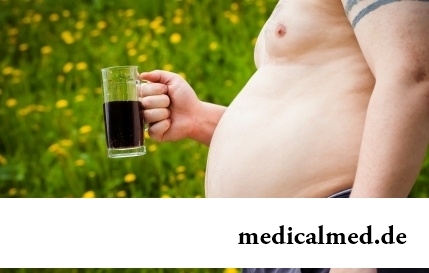
There is a lot of fans of beer in our country. Statistically, on each average Russian (including women and children) in a year about 60 liters of this drink are consumed. It is not a lot of, as in the Czech Republic or Germany, but figure all the same impressive. Radova...
Section: Articles about health
(Xerostomia) many people consider feeling of a xerostomia small and easily removable inconvenience. This delusion: the symptom can demonstrate existence of serious diseases. It is worth to remember also that saliva performs important functions in an organism: clears the surface of teeth of a food plaque, growth of pathogenic microorganisms oppresses, normalizes acid-base balance, liquefies food and helps to split the carbohydrates which are contained in it. Chronic deficit слюн...
Section: Articles about health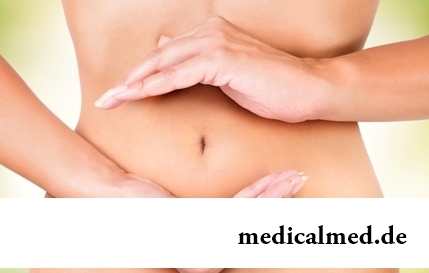
The pancreas performs two functions in a human body: release of enzymes without which digestion carbohydrate is impossible...
Section: Articles about health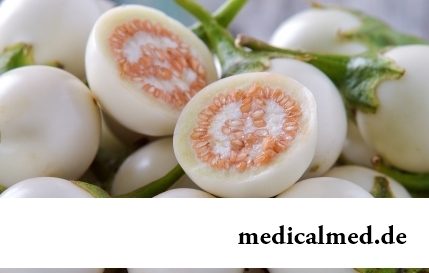
It is possible to find the extensive range of fruit and vegetables in modern shops. Russians already got used that on counters there is not only a seasonal domestic production, but the vegetables and fruit which are grown up in the countries with more comfortable conditions at all seasons of the year...
Section: Articles about health
Within several decades of our compatriots convinced that the use of butter nasty affects a condition of coronary vessels. As a result the reputation of a product was impaired thoroughly a little, and many almost ceased to include it in the diet, having given preference "to safer" to vegetable fats. Meanwhile, the last researches showed that harm of butter for health is strongly exaggerated. But the product has a number of unique properties, to...
Section: Articles about health
Feeding by a breast - the integral part of ideal motherhood allowing to come into contact with the kid and to create since early years...
Section: Articles about health
The advantage of swimming for the person is so high that this sport is not only the most popular, but also is widely applied in medicine and rehabilitation processes. If you look for for yourself the occupation allowing pleasantly and to spend time, then swimming with advantage...
Section: Slideshow
The way of life of people promptly changes from year to year: if about ten years ago the personal computer was not in each family, then today already very few people do without this device. Certainly, and children master the computer at full speed: they not only play on it games, but also study, and write school works, and search for necessary information....
Section: Articles about health
Bathing in broths of medical flowers and plants (phytobathtub) was eurysynusic since Cleopatra who is a good judge of everything...
Section: Articles about health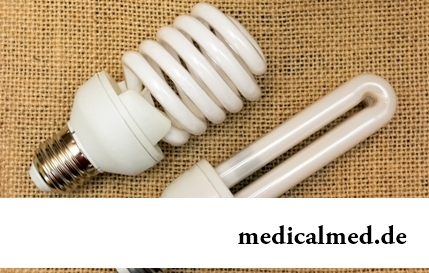
Energy saving lamps are one of the most popular products of innovative technologies, and there is no wonder: they much more economic also are more long-lasting than usual filament lamps. At the same time there are fears that energy saving bulbs can become the reasons...
Section: Articles about health
Diapers for adults – individual one-time means of hygiene which in some situations is irreplaceable and from such situations any person is not insured. Though nobody perceives need of their use with enthusiasm, however without such means already problematic situation could be heavier....
Section: Articles about health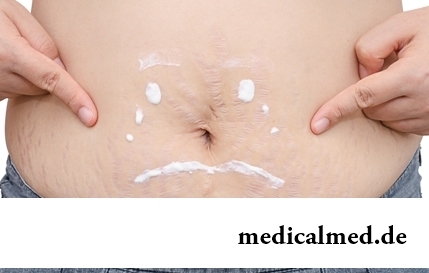
Striya (extension) are the defects of skin having an appearance of direct or wavy strips from 1 to 10 cm long and 1-5 mm wide. In the majority with...
Section: Articles about health
At this plant there are a lot of names: tuberiferous sunflower, Jerusalem artichoke, solar root, earth pear. Contrary to popular belief, it is not an exotic plant at all. The wild girasol grows in a midland of Russia practically everywhere: at the edges of roads...
Section: Articles about health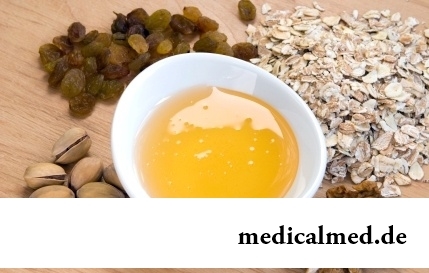
Let's begin with the fact that a separate illness which is called "adjournment of salts", just does not exist. In practice this household name of disbolism leading to development of a number of diseases. Pathological process consists that in an organism there is an accumulation of salts of uric acid (as a rule, owing to failure of a water salt metabolism or insufficiently effective work of secretory system)....
Section: Articles about health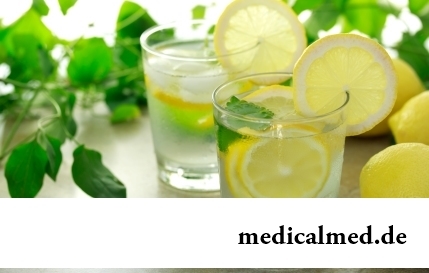
Water with a lemon - idle time in preparation drink which supporters of a healthy lifestyle already managed to appreciate. Upo...
Section: Articles about health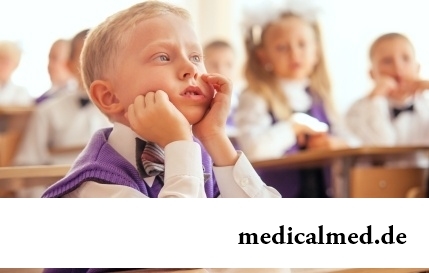
Since the moment when the child becomes a school student, his sight begins to be exposed to the strengthened loadings which are supplemented with viewing of animated films and long computer games. During this period of life of the child development not completely created bodies to a zra...
Section: Articles about health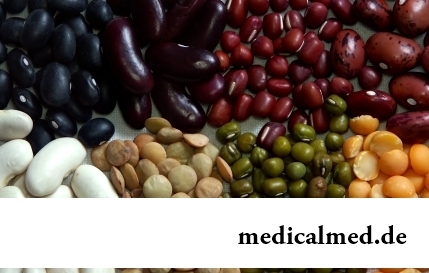
Ability of an organism to resist to adverse environmental factors (to impact of temperature drops, humidity and pressure, to the attacks of causative organisms, etc.) directly depends on what the person eats. Business here not only in that cells of a body received a necessary set of nutrients, vitamins and microelements. Scientists established that such components which are capable to influence negatively immune system, in connection with also are a part of foodstuff...
Section: Articles about health
